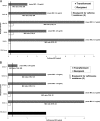High-level cefixime- and ceftriaxone-resistant Neisseria gonorrhoeae in France: novel penA mosaic allele in a successful international clone causes treatment failure
- PMID: 22155830
- PMCID: PMC3294892
- DOI: 10.1128/AAC.05760-11
High-level cefixime- and ceftriaxone-resistant Neisseria gonorrhoeae in France: novel penA mosaic allele in a successful international clone causes treatment failure
Abstract
Recently, the first Neisseria gonorrhoeae strain (H041) highly resistant to the expanded-spectrum cephalosporins (ESCs) ceftriaxone and cefixime, which are the last remaining options for first-line gonorrhea treatment, was isolated in Japan. Here, we confirm and characterize a second strain (F89) with high-level cefixime and ceftriaxone resistance which was isolated in France and most likely caused a treatment failure with cefixime. F89 was examined using six species-confirmatory tests, antibiograms (33 antimicrobials), porB sequencing, N. gonorrhoeae multiantigen sequence typing (NG-MAST), multilocus sequence typing (MLST), and sequencing of known gonococcal resistance determinants (penA, mtrR, penB, ponA, and pilQ). F89 was assigned to MLST sequence type 1901 (ST1901) and NG-MAST ST1407, which is a successful gonococcal clone that has spread globally. F89 has high-level resistance to cefixime (MIC = 4 μg/ml) and ceftriaxone (MIC = 1 to 2 μg/ml) and resistance to most other antimicrobials examined. A novel penA mosaic allele (penA-CI), which was penA-XXXIV with an additional A501P alteration in penicillin-binding protein 2, was the primary determinant for high-level ESC resistance, as determined by transformation into a set of recipient strains. N. gonorrhoeae appears to be emerging as a superbug, and in certain circumstances and settings, gonorrhea may become untreatable. Investigations of the biological fitness and enhanced understanding and monitoring of the ESC-resistant clones and their international transmission are required. Enhanced disease control activities, antimicrobial resistance control and surveillance worldwide, and public health response plans for global (and national) perspectives are also crucial. Nevertheless, new treatment strategies and/or drugs and, ideally, a vaccine are essential to develop for efficacious gonorrhea management.
Figures


Comment in
-
Management of pharyngeal gonorrhea is crucial to prevent the emergence and spread of antibiotic-resistant Neisseria gonorrhoeae.Antimicrob Agents Chemother. 2012 Jul;56(7):4039-40; author re[ply 4041-2. doi: 10.1128/AAC.00505-12. Antimicrob Agents Chemother. 2012. PMID: 22700700 Free PMC article. No abstract available.
References
-
- Boslego JW, et al. 1987. Effect of spectinomycin use on the prevalence of spectinomycin-resistant and penicillinase-producing Neisseria gonorrhoeae. N. Engl. J. Med. 317:272–278 - PubMed
-
- Centers for Disease Control and Prevention 2011. Cephalosporin susceptibility among Neisseria gonorrhoeae isolates—United States, 2000-2010. MMWR Morb. Mortal. Wkly. Rep. 60:873–877 - PubMed
Publication types
MeSH terms
Substances
Grants and funding
LinkOut - more resources
Full Text Sources
Other Literature Sources
Medical

